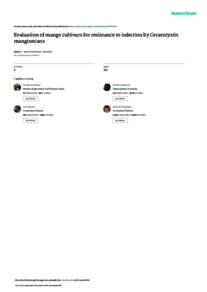Document
The Mango sudden decline pathogen, ceratocystis manginecans, is vectored by hypocryphalus mangiferae (coleoptera: scolytinae) in Oman.
Identifier
DOI: 10.1007/s10658-012-0081-7
Contributors
Al-Jabri, R. M., Author
Deadman, M. L., Author
Barnes, I., Author
Wingfield, B., Author
Wingfield, M. J., Author
Publisher
Springer.
Gregorian
2012-09
Language
English
English abstract
In Oman, the bark beetle Hypocryphalus mangiferae is closely associated with trees affected by mango sudden decline disease caused by Ceratocystis manginecans. Although it has previously been assumed that this beetle plays a role in the dispersal of the pathogen, this has not been established experimentally. The aim of this study was to determine whether H. mangiferae vectors C. manginecans from infected to healthy mango trees. A survey conducted in northern Al Batinah region of Oman revealed that H. mangiferae was closely associated with mango sudden decline disease symptoms and it was found on trees in the early stages of the disease. Healthy, 2-year-old mango seedlings were exposed to H. mangiferae collected from diseased mango trees. Seedlings were infested by the bark beetles and after 6 weeks, typical mango sudden decline disease symptoms were observed. Ceratocystis manginecans was isolated from the wilted mango seedlings while uncolonized control seedlings remained healthy. The results show that H. mangiferae vectors C. manginecans in Oman and is, therefore, an important factor in the epidemiology of this disease.
Member of
ISSN
0929-1873
Resource URL
Category
Journal articles



